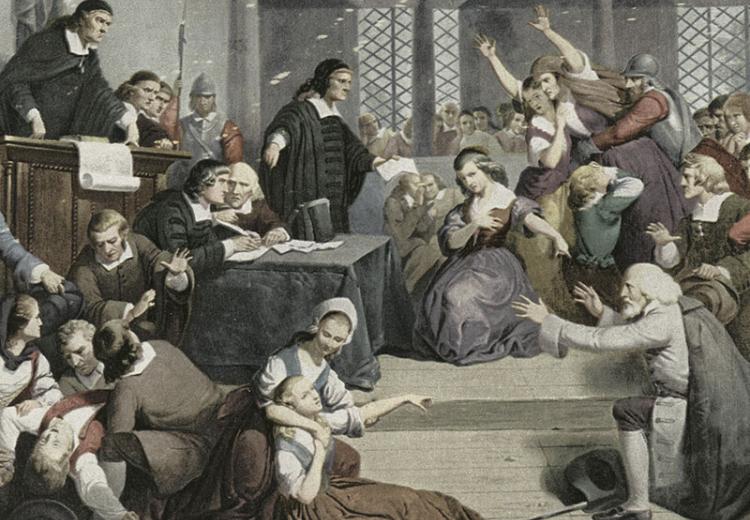Salem Witch Trials: Understanding the Hysteria

Trial of George Jacobs for Witchcraft, Salem, Mass.
Life in Puritan New England
Just as the society around us shapes the way we think and act, so did it shape the people of Salem, Massachusetts in the 1600s. Look at the websites listed below, and, on a separate sheet of paper, answer the questions about life in Puritan New England. Note that many of the websites contain interactive images. Click on the images to open them, and mouse-over the image to discover more about it.
Group One
- The Puritans
- The Puritan Idea of the Covenant
- New Groups: A Great Migration
- Working: "To 1 day work at my house"
- Beliefs: A City upon a Hill
- What values that we now consider 'American' were contributed by the Puritans?
- In the 1920s, how did people remember the Puritans? Define the word 'caricature' and explain how it relates to the Puritans.
- To what extent did Puritans condemn alcohol consumption, artistic beauty, and poetry?
- What did the Puritans believe was the primary purpose of government?
- What did the Puritans think about the separation of church and state?
- What is a 'separatist'? Were the Puritans 'separatists'? If not, describe their philosophy regarding the Church of England.
- What is a 'covenant'? Explain the function of 'covenants' in the way the Puritans saw the world.
- Did Puritans believe in tightly knit communities and families, or did they value families that were dispersed?
- Describe some reasons why Puritans came to America from Europe.
- What were some of the strategies New England colonists used to deal with the labor shortage?
- Describe some of the religious beliefs of the Puritans.
Group Two
- The Puritans
- Gender Roles: Beliefs and Gender Roles
- Education: Print and Protestantism
- Customs: Possessions Reveal Social Standing
- Getting Things: Importing Status
- Child Life: Fleeting Mortality
- What values that we now consider 'American' were contributed by the Puritans?
- Look up the word 'Patriarchal' in the dictionary. Define what it means, in your own words.
- What were some of the responsibilities of men in the 1700s in Colonial New England?
- What were some of the responsibilities of women?
- Explain how the story of Adam and Eve was used to perpetuate prevailing ideas about men and women.
- Were schools important in New England? Did people know how to read?
- Were there as many schools in other parts of America as there were in New England?
- Did wealthy people tend to spend a lot of money? What are some of the things you think they would buy?
- What does 'conspicuous consumption' mean?
- Why did so many children die at young ages in colonial New England?
Group Three
- The Puritans
- The Land 1680-1720
- Agriculture: Agriculture and Community
- Public Space: The Meeting House
- What values that we now consider 'American' were contributed by the Puritans?
- How did most Europeans view the North American Landscape?
- What were some early colonial industries?
- What was the center of public and religious life in New England?
- Describe the common field system.
- What were some results of European fences, mills, grass, and livestock being brought to New England?
- Explain how a mill worked.
- What were the criteria that a committee would use to 'seat' the meetinghouse?
- Who was allowed to vote? What did they vote on?
John Dane's Narrative
Read the first five paragraphs of John Dane's Narrative, until you reach the follow passage:
"Then said my mother, "go where you will, God he will find you out." This word, the point of it, stuck in my breast; and afterwards God struck it home to its head."
- What does John Dane's piece about morality tell you about Puritan life?
- Define 'Providence' and explain John Dane's beliefs about Providence.
- In the third paragraph of John Dane's narrative, he relates a story about his upbringing.
- In a paragraph, explain how this story makes you feel. How is this different or similar to your own interactions with your parents?
- Choose one paragraph in John Dane's narrative and summarize it in your own words.
Making it Personal
Your instructor will assign to you a person from the Salem Witch Trial historical record. Find your assigned person on the website 'Important Persons in the Salem Court Records' and write five sentences about him or her answering some of the following questions, or similar questions that you come up with on your own. Pay close attention to your individual's history and personality, as you will follow him or her throughout the remainder of the lesson.
Important Persons in the Salem Court Records
- How old was the person?
- What was the person's occupation?
- What do we know about the person's family?
- Why do people think this person was accused of witchcraft and/or accused others of witchcraft?
- What is most remembered in about this person in current popular culture, if anything?
- Was this person wealthy or poor?
- Where did this person live?
Witchcraft, Trials, and The Historical Record
Your instructor will guide you through a series of activities using some of the following resources.
- Words About the Word 'Witch', via Digital History
- Witchcraft, History Matters
- Chronology via the Salem Witch Trials Documentary Archive
- Petition for bail from accused witches (American Memory)
- National Archives Primary Document Analysis Workshheet
- How to Read Old Documents (from American Centuries)
- Salem Witch Trials Documentary Archive
